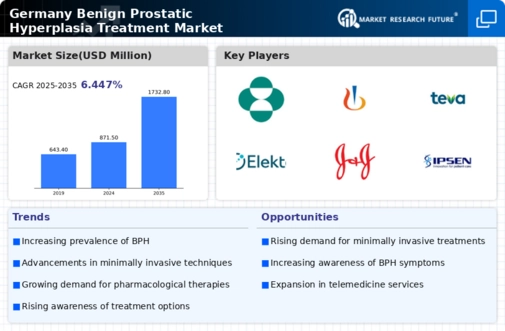Aging Population in Germany
The demographic shift towards an aging population in Germany is a crucial driver for the benign prostatic-hyperplasia-treatment market. As men age, the incidence of benign prostatic hyperplasia (BPH) increases significantly, with studies indicating that approximately 50% of men aged 60 and older experience symptoms. This growing patient population necessitates a corresponding increase in treatment options and healthcare services. The benign prostatic-hyperplasia-treatment market is likely to expand as healthcare providers adapt to the needs of older patients, offering both pharmaceutical and surgical interventions. Furthermore, the increasing life expectancy in Germany suggests that the demand for effective BPH treatments will continue to rise, thereby influencing market dynamics and encouraging investment in innovative therapies.
Increased Healthcare Expenditure
Germany's commitment to healthcare expenditure plays a pivotal role in the benign prostatic-hyperplasia-treatment market. With healthcare spending accounting for approximately 11.7% of the country's GDP, there is a strong emphasis on providing comprehensive care for chronic conditions like BPH. This financial backing facilitates access to a wide range of treatment options, including medications and surgical interventions. As the government continues to invest in healthcare infrastructure, the benign prostatic-hyperplasia-treatment market is expected to experience growth, driven by improved access to care and the availability of advanced treatment modalities. Additionally, increased funding for research initiatives may lead to the development of new therapies, further enhancing the market landscape.
Rising Prevalence of Comorbidities
The rising prevalence of comorbidities among the aging male population in Germany is influencing the benign prostatic-hyperplasia-treatment market. Conditions such as diabetes, hypertension, and obesity are often associated with BPH, complicating treatment approaches. As the number of patients with multiple health issues increases, healthcare providers are challenged to develop comprehensive treatment plans that address both BPH and its comorbidities. This complexity may drive demand for more integrated treatment solutions, thereby impacting the benign prostatic-hyperplasia-treatment market. Furthermore, the need for multidisciplinary care teams may lead to increased collaboration among healthcare professionals, ultimately enhancing patient outcomes and satisfaction.
Growing Focus on Patient-Centric Care
The growing focus on patient-centric care is reshaping the benign prostatic-hyperplasia-treatment market in Germany. Patients are increasingly seeking personalized treatment options that align with their preferences and lifestyles. This shift is prompting healthcare providers to adopt a more holistic approach, considering factors such as quality of life and treatment satisfaction. As a result, there is a rising demand for therapies that not only alleviate symptoms but also enhance overall well-being. The benign prostatic-hyperplasia-treatment market is likely to evolve in response to this trend, with an emphasis on developing treatments that prioritize patient needs and preferences, potentially leading to improved adherence and outcomes.
Advancements in Minimally Invasive Procedures
Recent advancements in minimally invasive procedures are reshaping the benign prostatic-hyperplasia-treatment market. Techniques such as laser therapy and transurethral microwave thermotherapy (TUMT) have gained traction due to their effectiveness and reduced recovery times. In Germany, the adoption of these technologies is on the rise, with a reported increase in procedures performed annually. This shift towards less invasive options is appealing to both patients and healthcare providers, as it often results in fewer complications and shorter hospital stays. The benign prostatic-hyperplasia-treatment market is likely to benefit from this trend, as more patients seek out these innovative solutions, leading to a potential increase in market share for companies specializing in such technologies.

























Leave a Comment